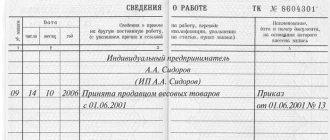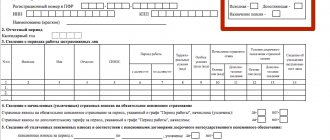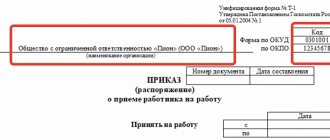When creating a numbering system and maintaining document flow at an enterprise, one must be guided by the requirements laid down in such regulations as the law on archival affairs No. 125-FZ of October 22, 2004 and order of the Ministry of Culture of the Russian Federation No. 558 of August 25, 2010.
They establish general storage periods for personnel orders, and also provide a fairly simple classification of various personnel documents. In addition, some industry departments are also developing separate provisions for document management in their subordinate organizations.
Types of orders and the need for their registration
Employment order form
Particular attention in the personnel document management industry is paid to the creation of orders. Administrative documents are divided into 2 groups:
By personnel. This type of orders is divided into 2 groups:
- The retention period is 75 years for orders that form labor relations and significant changes in the lives of employees. (Hiring, dismissal, change of name);
- The shelf life is 5 years for short-term orders. (Vacation, business trip, reprimand).
By main activity:
- General orders throughout the enterprise;
- By department;
- For administrative and economic activities;
On a note! When preparing orders, use unified documents approved by Decree of the State Statistics Committee of Russia dated January 5, 2004 No. 1. It is acceptable to issue orders in any form, since unified forms do not cover the entire range of personnel operations.
Administrative documents without an approved form are drawn up in text form on the official letterhead of the organization.
In order for orders to have legal force, they must contain the necessary details, signatures of responsible persons and document number.
Important! In Federal Law No. 43 dated March 2, 2016. “On amendments to the Federal Law “On Archiving in the Russian Federation”, new shortened storage periods for documents on personnel have been introduced. Now they must be kept in the organization for 50 years, with the exception of those created before 2003. Their shelf life remains 75 years.
A well-organized order registration system allows you to:
- Speed up the search for the required document;
- Systematize administrative documents according to their intended purpose;
- Strengthen control over the execution of orders from superiors.
The specifics of using numbering are the following:
- Separation of administrative documents with different storage periods;
- Assigning complex numbers to orders with significant document flow.
Federal Law of March 2, 2016 N 43-FZ “On Amendments to the Federal Law on Archival Affairs in the Russian Federation”
Resolution of the State Statistics Committee of Russia dated January 5, 2004 No. 1 “On approval of unified forms of primary accounting documentation for recording labor and its payment”
Why do you need document numbering?
In small businesses, the volume of personnel documentation is limited. Therefore, all papers can be easily disassembled if necessary. However, if the company has more than a hundred employees, documents will be processed almost every day. For operational orientation in them, numbering is needed. It solves the following problems:
- Quickly search for the required act.
- Conveniently find connections between several documents (for example, between an order to reduce staff and an order to terminate an employment agreement).
- Ensuring proper storage of documentation.
- Systematization of acts based on their content.
- Creating a procedure for registering papers.
- Simplifying the classification of documents when registering them for storage.
- Dividing orders into groups.
Each document has its own shelf life. Only after this period has expired can the paper be destroyed. Numbering is also a tool for indicating storage periods.
What does number assignment mean?
Numbering is the process of assigning a specific number to a document. The procedure involves distinguishing between papers with different shelf life:
- Long-term: 50 or 75 years.
- Short term: 1 or 5 years.
Document numbers are complex, that is, they contain numbers and letters. The need for complex numbers is due to the wide variety of papers. Every year the enterprise must update the calculation procedure. At the beginning of the year, the numbers of new securities begin with the number 1.
Rules of conduct
Example of a dismissal order
The registration number of the order consists of its serial number and index. The indexation of the order is determined by the individual nomenclature of cases and the rules for registering orders at the enterprise. Despite the fact that each organization prescribes its own numbering order for administrative documents, there is a certain number of general rules that firms try to adhere to. Namely:
In companies with a small document flow, there is no need to separate orders into numerous types. But they cannot be combined due to different storage periods for documents. In this case, a letter index is added to the order number through a hyphen or slash:
- “personnel” - personnel (Orders for personnel with a shelf life of 75 years);
- “k” - frames (Orders for short-term storage periods).
In organizations with a large staff of employees and administrative documents, a whole system of indexes has been developed for each type of order:
- “p” - hiring;
- “u” - dismissal;
- “pr” - hiring workers;
- “k” - business trips;
- “vk” - internal business trips;
- “zk” - business trips abroad;
- “department” - leave without pay, for pregnancy and childbirth, for child care;
- “otk” - regular vacations, study vacations;
On a note! For orders on core activities, personnel officers usually use a digital code. Some organizations add a letter index, for example, order No. 1-OD.
There can be many options for numbering and index designations. Their diversity depends not only on the size of the organization, but also on the specifics of the activities of a particular company.
Note! The procedure for conducting personnel records management, including the numbering of orders, must be formalized in a local document of the company - the regulation on personnel records management.
Legislation governing the numbering of personnel documents
In every organization, personnel documents are constantly drawn up - when hiring and dismissing employees, when issuing orders and adopting collective agreements, and in many other cases. In order for documents to be systematized and each paper to be easy to find, various methods are used, the main one of which is the numbering of all personnel documentation.
In organizations and individual entrepreneurs, a unified document flow system is not fixed at the legislative level, but this does not mean that it does not need to be introduced. Consolidation of such a system is possible with the help of local acts adopted in the manner established by Art. 40 Labor Code of the Russian Federation. Local acts are adopted taking into account the requirements of the Federal Law “On Archiving in the Russian Federation” dated October 22, 2004 No. 125-FZ, Order of the Main Archive of the USSR dated May 25, 1988 No. 33, Order of the Ministry of Culture of Russia dated August 25, 2015 No. 558, and other acts.
With a well-developed personnel document management system, which includes the numbering order of orders, it will be much easier to understand the endless stream of documents.
Order log
Page of the logbook for registering orders for personnel
Since the procedure for assigning numbers to orders is not established at the legislative level, personnel officers keep logbooks for registering orders. The registration process involves copying details from a document and entering this data into a special registration form.
Orders for core activities are maintained at the enterprise separately from orders for personnel. This is due to different areas of activity and shelf life. The numbering of these administrative documents must be kept separately. The order logs will be different.
Note! Registration of a document gives it legal force; it establishes the fact of its creation or receipt.
Labor legislation does not oblige enterprises to keep order logs. Log books are developed by each company independently. But they must contain not only the numbering, but also the date of execution of the document, details, summary and signatures of the responsible persons.
On a note! When registering an order for personnel, you must indicate the surname and position of the employee. And to the order to pin the base - a statement from him.
Thus, there are no strict guidelines for implementing an order numbering accounting system. Each company chooses its own scheme based on expediency and convenience.
Deadlines
The frequency of issuing such an order is once a year. Each subsequent business year is a reason for a new signing. Thus, orders from different years have less chance of ending up in one folder. Transferring papers to the archive becomes a more streamlined process. Therefore, most heads of organizations prefer to sign an order on the numbering of orders at the beginning of the new year, in January. The only exceptions will be organizations in the sphere of education and culture. Their year begins on September 1, and it is advisable to count written orders from this date.
What to do if there is an error
Amendments to a previously issued order are permitted subject to compelling necessity, primarily legal. Amendments to the order are required when circumstances arise that make the administrative document or its individual paragraph factually or legally inaccurate.
The most common circumstances include:
- Changes in legislation, regulations or local acts of the organization itself
- Changes in personal data of employees in respect of whom administrative documents were created
- Changes in the circumstances of a particular time and place, if these points are significant to the previously issued order
Important! Making changes to an administrative document by rewriting it in accordance with new circumstances is a legally illiterate action!
It is required to draw up an order to amend a previously issued order. It includes:
- Reasons for changes.
- Reason for making changes.
- Indicating actions to officials or a structural unit of the company that they must perform in connection with a change in the order.
- A link to the amended order or position in it, its date, number and name.
- Indication of the employee who is entrusted with control over the execution of the document.
Advice! When making a large list of additions and changes, it is more convenient to form them into a separate application. And in the order, indicate a list of adjustments and a link to this appendix to the order.
The execution of an order to amend a previously issued order is issued in paper form. Desirable details include:
- Company name;
- Name and date of the document;
- Registration number;
- Place of drawing up the order;
- Document text;
- Signatures of responsible persons;
- Mark about the performer;
- Visas for order approval (if necessary).
Note! The legislation does not stipulate how many changes can be made to the order. The management of the organization decides this issue itself. It should be approached from a rational perspective, since making changes to the order to change the order will entail confusion in the documents.
Meaning
The effectiveness of the functionality of an enterprise of any size is determined, among other things, by the state of its office work. It is impossible to work where there is no order. In order to introduce the numbering of orders, their indexing and to implement a systematic policy of consistent paperwork, there is an order on the numbering of orders. Employees responsible for personnel records management in the company carry out:
- filling out work books;
- formation of personal files, as well as job descriptions;
- drawing up orders for personnel;
- control over the formation of staffing and compliance with the vacation schedule;
- storage of documentation, if necessary - delivery of it to archives;
- if necessary, make changes to existing papers.
Nuances
It happens that for orders on core activities, the company’s personnel department leaves only a digital code. This numbering system is also one of the acceptable options. Letter indexing in orders will immediately follow the number through a vertical bar or hyphen. Such procedures are accepted in the preparation of official documentation.
The procedure for maintaining orders in a company must be prescribed in the adopted regulations on personnel records management. Otherwise, the decisions made will be legally incorrect.
Briefly about the main thing
Orders must be numbered. This allows you to solve several management and legal problems at once by putting things in order in the document collection.
What will happen to unused vacations in 2021? You will find out.
The numbering order must be documented at the departmental level or at the level of the organization itself. The number can be numeric or alphanumeric. Numbering starts anew every calendar year.
The numbering of orders in personnel records plays a significant role in the functioning of a company, regardless of its size, structure and field of activity.
Personnel records management is a branch of an organization responsible for maintaining documents related to labor relations. Namely:
- Making entries in work books;
- Registration of personal files;
- Creation of orders for personnel;
- Preparation of vacation schedules and staffing;
- Drawing up and transformation of job descriptions;
- Storage and timely submission of documents to the archive;
- Competently making changes to documents;
Specifics
The order on the numbering of orders is intended not only to document that the organization is starting to number written orders of the manager or persons with appropriate authority. The document is intended to fix the system of letter indexes. Each of the indexes has its own decoding, for example:
- “p” - the employee is hired;
- “y” - dismissal occurs;
- “ls” - orders for personnel;
- “k” - business trips, and separately “vk” - business trips within the organization and “zk” - foreign business trips;
- “from” - the employee goes on vacation.
Indices are adopted by each organization separately, depending on its specifics and size. Small companies may limit themselves to two or three indices. Large companies are moving to a new “level” of numbering, since it is more convenient to conduct office work.
In short, even if the organization has already adopted rules for registering orders, a separate order dedicated to the numbering of orders will not be superfluous.






